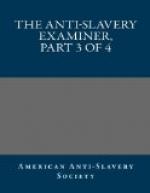“A man, more avaricious than humane, as is the case with most of the rich planters, laid a remote claim to those two modest, unassuming, innocent and free young ladies as his property, with the design of putting them into the field, and thus increasing his STOCK! As well as the people of Concord are known to be of a peaceful disposition, and for their love of good order, I verily believe if a similar trial should be brought forward there and conducted as this was, the good people would drive the lawyers out of the house. Such would be their indignation at their language, and at the mean under-handed manner of trying to ruin those young ladies, as to their standing in society in this district, if they could not succeed in dooming them for life to the degraded condition of slavery, and all its intolerable cruelties. Oh slavery! if statues of marble could curse you, they would speak. If bricks could speak, they would all surely thunder out their anathemas against you, accursed thing! How many white sons and daughters have bled and groaned under the lash in this sultry climate,” &c.
Under date of March, 1832, Mr. G. writes, “I have been doing what I hope never to be called to do again, and what I fear I have badly done, though performed to the best of my ability, namely, sewing up a very bad wound made by a wild hog. The slave was hunting wild hogs, when one, being closely pursued, turned upon his pursuer, who turning to run, was caught by the animal, thrown down, and badly wounded in the thigh. The wound is about five inches long and very deep. It was made by the tusk of the animal. The slaves brought him to one of the huts on Mr. Tripp’s plantation and made every exertion to stop the blood by filling the wound with ashes, (their remedy for stopping blood) but finding this to fail they came to me (there being no other white person on the plantation, as it is now holidays) to know if I could stop the blood. I went and found that the poor creature must bleed to death unless it could be stopped soon. I called for a needle and succeeded in sewing it up as well as I could, and in stopping the blood. In a short time his master, who had been sent for came; and oh, you would have shuddered if you had heard the awful oaths that fell from his lips, threatening in the same breath “to pay him for that!” I left him as soon as decency would permit, with his hearty thanks that I had saved him $500! Oh, may heaven protect the poor, suffering, fainting slave, and show his master his wanton cruelty—oh slavery! slavery!”
Under date of July, 1832, Mr. G. writes, “I wish you could have been at the breakfast table with me this morning to have seen and heard what I saw and heard, not that I wish your ear and heart and soul pained as mine is, with every day’s observation ‘of wrong and outrage’ with which this place is filled, but that you might have auricular and ocular evidence of the cruelty of slavery, of cruelties that mortal language can never describe—that




